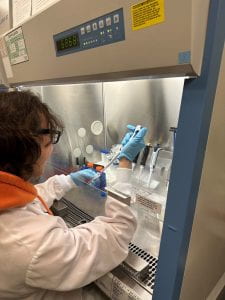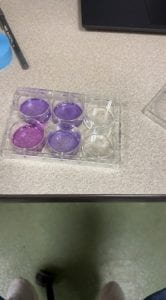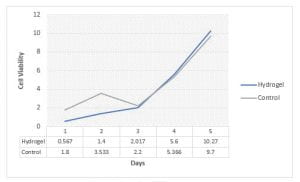Research in Bioengineering
Cell Viability of Novel Wound Healing Hydrogels
By Abid Neron
Introduction
Over the summer and my fall semester, I was culturing cells. I started off completely clueless but slowly I started learning and gaining a better understanding of the ins and outs of cell culture. I should start off by explaining what cell culture actually is. Basically, it’s growing a certain cell outside of its normal environment, in a lab. Cell culture is used to study these cells’ growth patterns and how to change their rate of growth. There are multiple cell lines/types, such as skin cells, kidney cells, cancer cells, and much more. I was mostly culturing HEK293 cells which are mammalian kidney cells. I also cultured A375 cells as well, these are a skin cancer cell line. I started off doing cell culture by just following a list of steps telling me what to do. I didn’t understand what I was doing, though. After some research and passaging my cells multiple times, I started to get an understanding of what cell culture is and the steps started making sense. Finally, after perfecting my technique, I wanted to start research using them. I talked to Dr. Tracie Ferreira, and she tasked me with creating a protocol to test cell growth on certain substances. This protocol would be used by the seniors on their final projects. I was introduced to the seniors and their projects and collaborated with them using my knowledge of cell culture.

Abid Neron passaging his cells inside a biosafety cabinet
Methods
Creating a standard protocol to test cell growth (Also known as cell viability) took a lot of research and multiple failed experiments but with each failed experiment I went back to the drawing board and tweaked some steps until I finally found the best method to test cell viability.
My cell viability test uses a substance called Resazurin which is a special dye that changes color depending on cell activity. Cells produce ATP. Resazurin changes color based on the amount of ATP produced. As cell number increases, so does the production of ATP. Further, Resazurin doesn’t affect cells’ growth and doesn’t damage them unlike other cell viability tests. Using a Spectrometer, I can analyze the change in color for each test. The larger the value the more cells were growing. After testing my protocol on students’ substances called Hydrogels, the test offered good results and could be replicated multiple times to get more accurate results if needed. Seniors are currently using the protocol I created to test cell viability on their Hydrogels.
I had an issue with bacteria growing on the hydrogels which would mess up the test, so after multiple experiments, I found the best way to sterilize the hydrogels and keep bacteria away from the cells by using different plates everyday to get more accurate results.

Cell Viability Test
(Notice how the bottom right well is a brighter color, that means that the cells are growing faster!)
Results
I tested my protocol on multiple hydrogels and compared their growth with cells growing under optimal conditions:

A hydrogel’s cell viability over 5 days
Discussion
My research is still ongoing and I’m constantly furthering my knowledge of cell culture and perfecting my technique. Cell culturing has become an almost therapeutic process for me. While there’s a lot to learn, it’s always nice to apply what I’m learning about. Researching cell culture is an incredible experience that I truly loved and sharing my experience with other students and teaching them cell culture and seeing their awe when they see cells growing is always rewarding. I wouldn’t have had this experience if it weren’t for Dr. Trace Ferreira. She taught me everything I know about cell culture and is always there to bounce ideas with. Going forward, I will test more hydrogels and hopefully teach more students how to apply my cell viability test in their own research.

